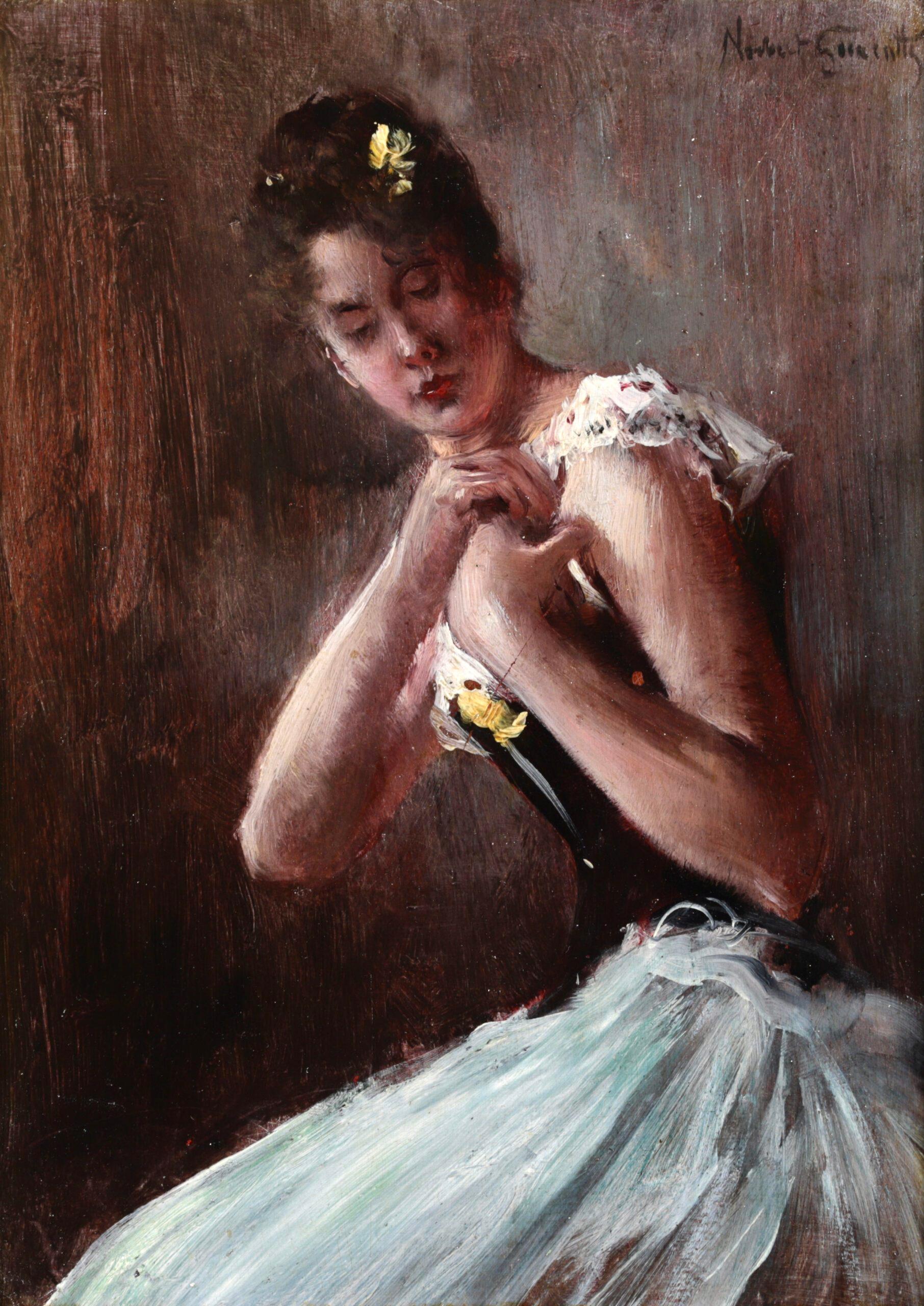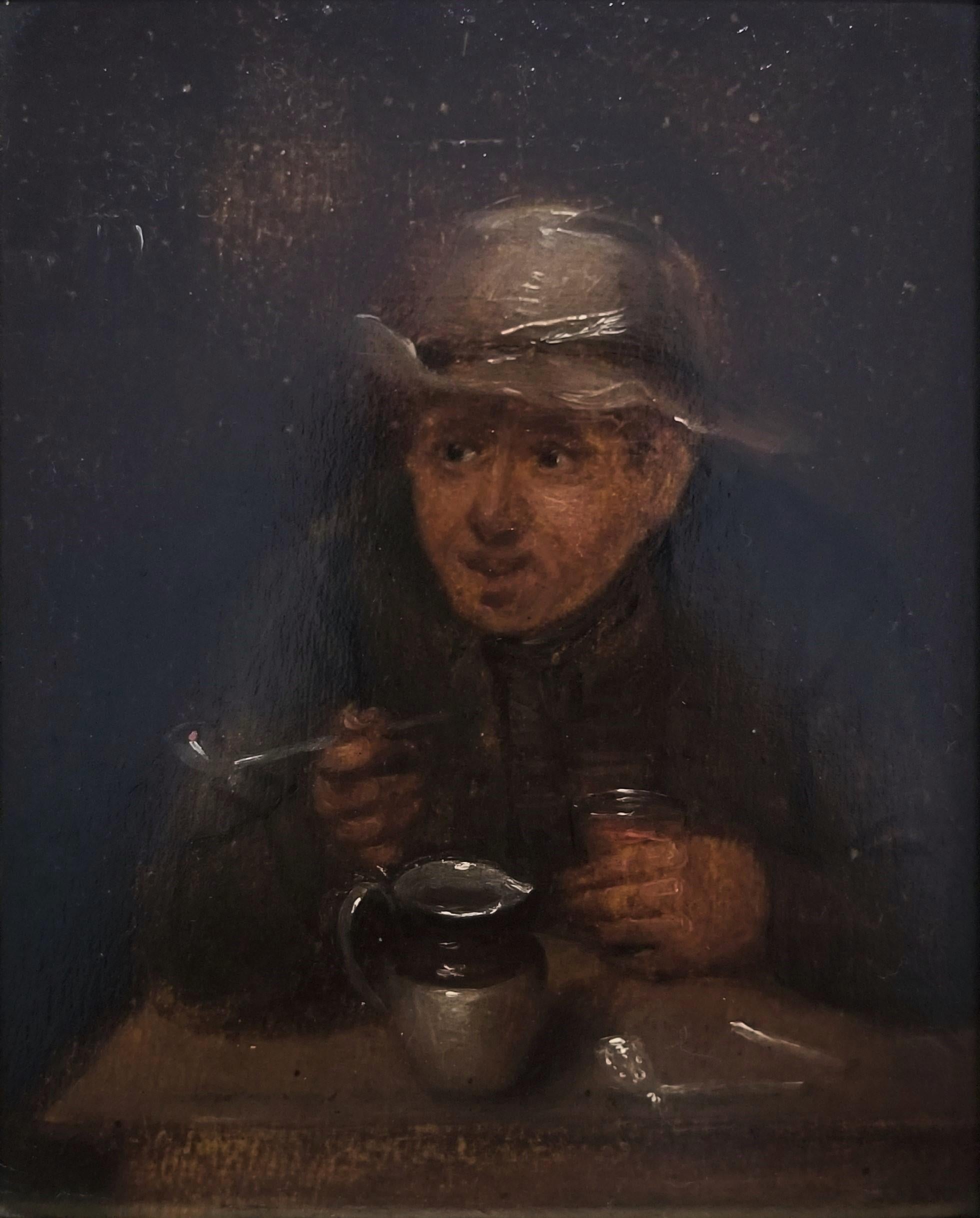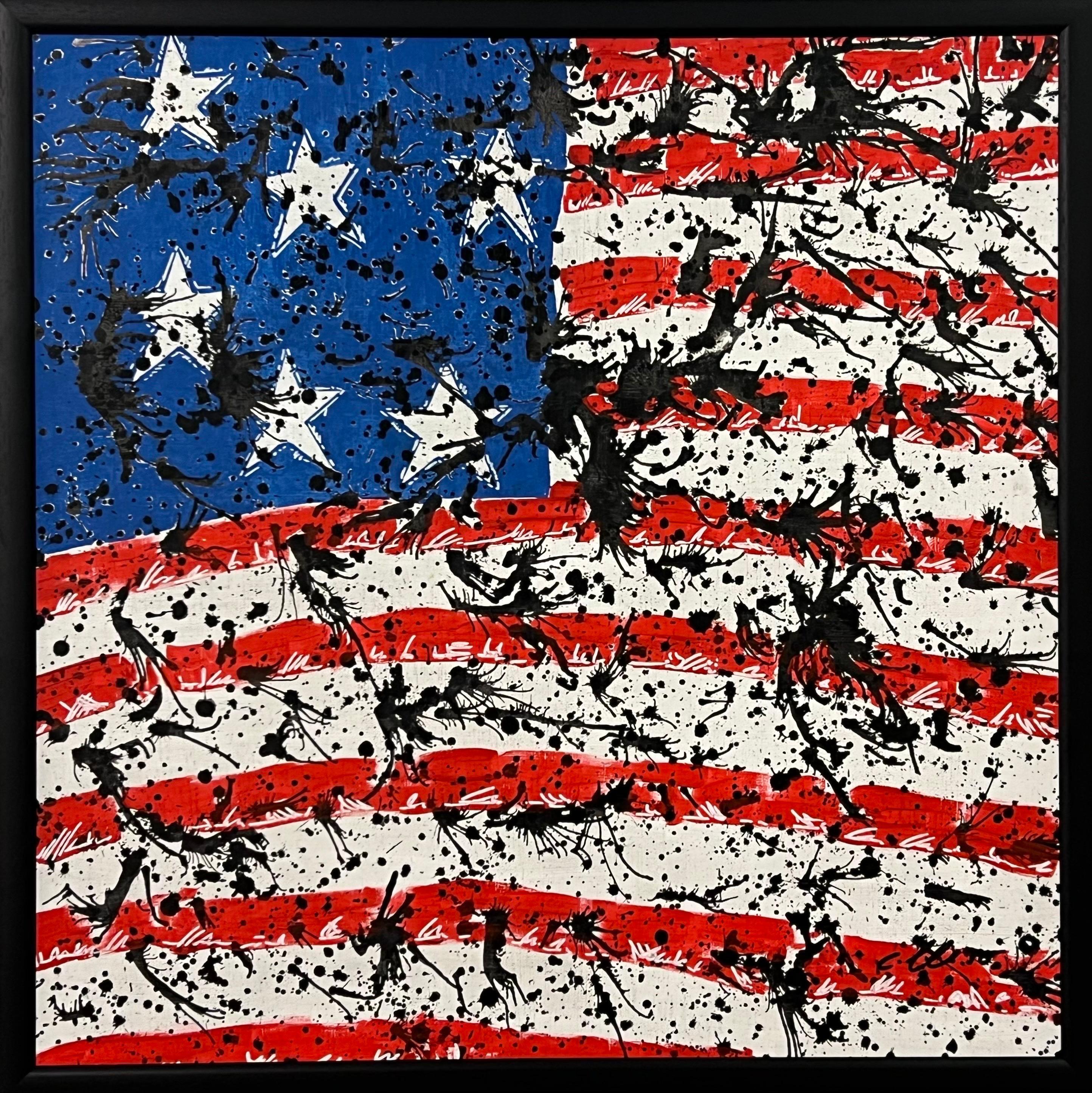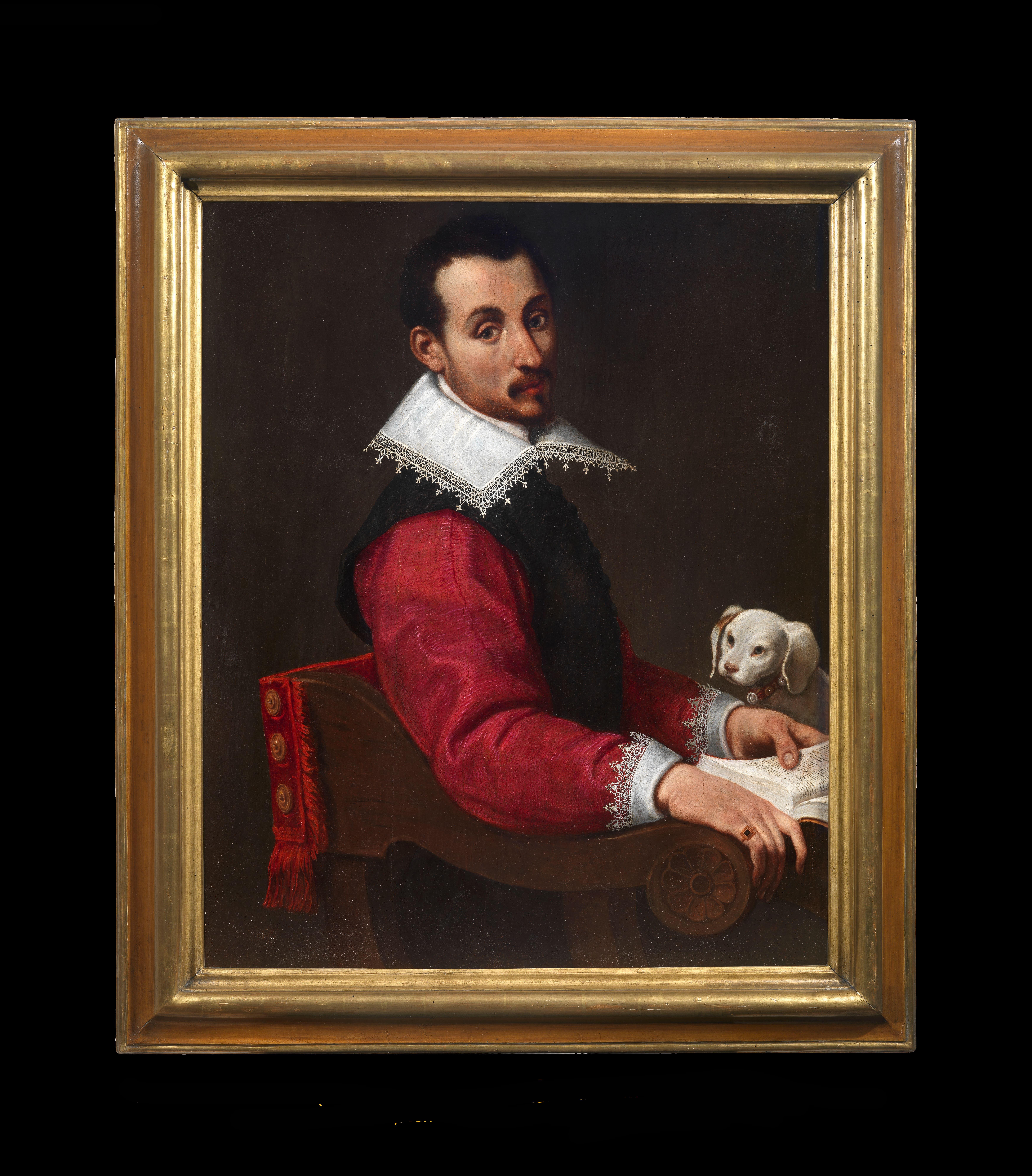Items Similar to Portrait of Thomas Cranmer, Archbishop of Canterbury, Mid 16th Century Oil
Want more images or videos?
Request additional images or videos from the seller
1 of 4
Mid 16th Century English SchoolPortrait of Thomas Cranmer, Archbishop of Canterbury, Mid 16th Century Oil
About the Item
Oil on panel
Image size: 12 1/2 x 8 3/4 inches (31.75 x 22.25 cm)
Period style hand made frame
This is a portrait of Thomas Cranmer (1489 - 1556). Cranmer was the Archbishop of Canterbury in the reign of Henry VIII and launched the English Reformation. Few people have played so important a part in shaping the course of English history or had a more profound influence on England's language and literature than Thomas Cranmer.
At the bottom of the painting Cranmer's name and title is inscribed. At the centre there is also Cranmer's coat of arms, the left half is the arms that all archbishops of Canterbury adopt and it has been enjoin to his own family arms that can be seen on the righthand side. It has been noted that Cramer swapped the original stars in his family crests for these pelicans. There was an old belief that pelicans feed their young with their own blood and Cranmer employed the animals to reflect his protestantism and emphasis on atonement by the blood of christ alone.
It is also likely that the books Cranmer holds in his hands are the 'Book of Common Prayer' which was written largely by Cranmer himself in 1549.
A similar portrait of Cranmer is currently in the art collection at Lambeth Palace, London.
- Creator:Mid 16th Century English School (1501 - 1550, English)
- Dimensions:Height: 12.5 in (31.75 cm)Width: 8 in (20.32 cm)
- More Editions & Sizes:1 of 1Price: $9,942
- Medium:
- Period:
- Condition:
- Gallery Location:London, GB
- Reference Number:1stDibs: LU52412163562
About the Seller
5.0
Vetted Seller
These experienced sellers undergo a comprehensive evaluation by our team of in-house experts.
Established in 2007
1stDibs seller since 2014
63 sales on 1stDibs
Typical response time: 2 hours
- ShippingRetrieving quote...Ships From: London, United Kingdom
- Return PolicyA return for this item may be initiated within 14 days of delivery.
More From This SellerView All
- Portrait of William Herbert, 3rd Earl of Pembroke, Early 17th Century PortraitLocated in London, GBEnglish School, (circa 1600) Portrait of William Herbert, 3rd Earl of Pembroke Oil on panel, oval Image size: 29¼ x 23⅞ inches Painted wooden frame Provenance: 176, Collection of Francis Greville, 1st Earl of Warwick. The Trustees of the Lord Brooks’ Settlement, (removed from Warwick Castle). Sotheby’s, London, 22nd March 1968, lot 81. Painted onto wooden panel, this portrait shows a dark haired gentleman in profile sporting an open white shirt. On top of this garments is a richly detailed black cloak, decorated with gold thread and lined with a sumptuous crimson lining. With the red silk inside it’s all very expensive and would fall under sumptuary laws – so this is a nobleman of high degree. It’s melancholic air conforms to the contemporary popularity of this very human condition, evident in fashionable poetry and music of the period. In comparison to our own modern prejudices, melancholy was associated with creativity in this period. This portrait appeared in the earliest described list of pictures of Warwick castle dating to 1762. Compiled by collector and antiquary Sir William Musgrave ‘taken from the information of Lord & Lady Warwick’ (Add. MSS, 5726 fol. 3) is described; ‘8. Earl of Essex – an original by Zuccharo – seen in profile with black hair. Holding a black robe across his breast with his right hand.’ As tempting as it is to imagine that this is a portrait of Robert Devereux, the 2nd Earl Essex, we might take this with a pinch of salt. Its identification with this romantic and fatal Elizabethan might well have been an attempt to add romance to Warwick Castle’s walls. It doesn’t correspond all that well with Essex’s portraits around 1600 after his return from Cadiz. Notably, this picture was presumably hung not too far away from the castle’s two portraits of Queen Elizabeth I. The first, and undoubtedly the best, being the exquisite coronation portrait that was sold by Lord Brooke in the late 1970s and now hangs in the National Portrait Gallery. The second, described as being ‘a copy from the original at Ld Hydes’, has yet to resurface. The portrait eventually ended up being hung in the State Bedroom of Warwick Castle. Archival documents present one other interesting candidate. The Greville family’s earliest inventory of paintings, made in 1630 at their home Brooke House in Holborn, London, describes five portraits of identified figures. All five belonged to the courtier, politician and poet Sir Fulke Greville (1554-1628), 1st Baron Brooke, and were hung in the ‘Gallerie’ of Brooke House behind yellow curtains. One of them was described as being of ‘Lord of Pembrooke’, which is likely to have been William Herbert (1580-1630), 3rd Earl of Pembroke. William was the eldest son of Greville’s best friend’s sister Mary Sidney, and was brought up in the particularly literary and poetically orientated household which his mother had supported. Notably, the 3rd Earl was one of the figures that Shakespeare’s first folio was dedicated to in 1623. The melancholic air to the portrait corresponds to William’s own pretensions as a learned and poetic figure. The richness of the robe in the painting, sporting golden thread and a spotted black fabric, is indicative of wealth beyond that of a simple poet or actor. The portrait’s dating to around the year 1600 might have coincided with William’s father death and his own rise to the Pembroke Earldom. This period of his life too was imbued with personal sadness, as an illicit affair with a Mary Fitton had resulted in a pregnancy and eventual banishment by Elizabeth I to Wilton after a short spell in Fleet Prison. His illegitimate son died shortly after being born. Despite being a close follower of the Earl of Essex, William had side-stepped supporting Devereux in the fatal uprising against the Queen and eventually regained favour at the court of the next monarch James I. His linen shirt is edged with a delicate border of lace and his black cloak is lined on the inside with sumptuous scarlet and richly decorated on the outside with gold braid and a pattern of embroidered black spots. Despite the richness of his clothes, William Herbert has been presented in a dishevelled state of semi-undress, his shirt unlaced far down his chest with the ties lying limply over his hand, indicating that he is in a state of distracted detachment. It has been suggested that the fashion for melancholy was rooted in an increase in self-consciousness and introspective reflection during the late 16th and early 17th centuries. In contemporary literature melancholy was said to be caused by a plenitude of the melancholy humor, one of the four vital humors, which were thought to regulate the functions of the body. An abundance of the melancholia humor was associated with a heightened creativity and intellectual ability and hence melancholy was linked to the notion of genius, as reflected in the work of the Oxford scholar Robert Burton, who in his work ‘The Anatomy of Melancholy’, described the Malcontent as ‘of all others [the]… most witty, [who] causeth many times divine ravishment, and a kind of enthusiamus… which stirreth them up to be excellent Philosophers, Poets and Prophets.’ (R. Burton, The Anatomy of Melancholy, London, 1621 in R. Strong, ‘Elizabethan Malady: Melancholy in Elizabethan and Jacobean Portraits’, Apollo, LXXIX, 1964). Melancholy was viewed as a highly fashionable affliction under Elizabeth I, and her successor James I, and a dejected demeanour was adopted by wealthy young men, often presenting themselves as scholars or despondent lovers, as reflected in the portraiture and literature from this period. Although the sitter in this portrait is, as yet, unidentified, it seems probable that he was a nobleman with literary or artistic ambitions, following in the same vain as such famous figures as the aristocratic poet and dramatist, Edward de Vere...Category
Early 17th Century Old Masters Portrait Paintings
MaterialsWood Panel, Oil
- Portrait of a Boy in a Black Tunic - Early 17th Century OilLocated in London, GBFlemish School, Early 17th Century Portrait of a Boy in a Black Tunic Oil on panel Image size: 15¾ x 13⅛ inches This accomplished portrait of an unknown boy in his early teens was p...Category
17th Century Portrait Paintings
MaterialsPanel, Oil
- Portrait of a ManBy Cornelis DusartLocated in London, GBCircle of Cornelis Dusart Dutch 1660 - 1704 Portrait of a Man Oil on panel Image size: 7¾ x 5¼ inches Giltwood frame Cornelis Dusart Cornelis ...Category
17th Century Old Masters Portrait Paintings
MaterialsPanel, Oil
- Portrait of a Young Man - 17th Century Portrait in OilBy Pieter Harmensz VerelstLocated in London, GBCircle of Pieter Harmensz Verelst 1618 - 1678 Portrait of a Young Man Oil on oak panel Image size: 7 ½ x 5 ¾ inches Dutch ripple frameCategory
18th Century and Earlier Old Masters Portrait Paintings
MaterialsPanel, Oil
- Portrait of Geoffrey Chaucer, Oil on Oak Panel Portrait, 16th CenturyLocated in London, GBOil on oak panel Image size: 14 1/4 x 11 3/4 inches (36 x 30 cm) Period style frame This portrait shows Chaucer with a string of beads in one hand and a writing implement in the other. The Arms in the top left of the picture are the Arms of Chaucer, featuring a per pale argent and gules, a bend counterchanged. This painting appears to derive, like all other portraits of Chaucer, from an illustration in an early fifteenth-century manuscript, Hoccleve's De Regimine Principum. Here Hoccleve included one portrait of Chaucer, showing him with an inkhorn around his neck and holding a rosary in one hand. Since it is likely that Hoccleve had met Chaucer, many scholars believe this could be the most genuine representation of the English writer with all other depictions being seemingly based on it. In almost all portraits of Chaucer, including this one, the poet is shown wearing a pendant attached to his vest. This item is often considered to be a penner, included in the artworks as a sign of the general occupation of a writer. Whilst the pendant is generally accepted as a case for a writing instrument, possibly with equal plausibility, it has also been suggested that the item is an ampulla, a small lead vial containing water and the blood of St. Thomas Becket...Category
16th Century Portrait Paintings
MaterialsOil, Panel
- The Gold Brooch, Orientalist Oil Painting, Signed and dated 1894By Eugene Alexis GirardetLocated in London, GBOil on panel, signed, dated and inscribed ‘Bou Saada, 1894’ lower right Image size: 13 x 8 3/4 inches (33 x 22.25 cm) Ornate Gilt frame Euguene Alexis Girardet A child prodigy, Gi...Category
1890s Portrait Paintings
MaterialsOil, Panel
You May Also Like
- Dancer at the Opera - Impressionist Portrait Oil Painting by Norbert GoeneutteBy Norbert GoeneutteLocated in Marlow, BuckinghamshireSigned, titled and dated figurative oil on panel by French impressionist painter Norbert Goeneutte. The work depicts an elegant seated dancer getting dressed. She is wearing a dress with a black corset trimmed with yellow flowers around the bust and a white tuile skirt. A yellow flower contrasts against her dark hair. Signature: Signed upper right and titled and dated 1886 verso Dimensions: Framed: 9"x7" Unframed: 8"x6" Provenance: Private French collection Goeneutte studied under Pils and exhibited at the Salon from 1876 onwards. He was one of the organisers of the painter/engraver exhibitions ( Expositions des Peintres-Graveurs). His principal preoccupation lay in capturing scenes from everyday life in Paris, portraying its citizens and, above all, the women of the city. There is a discernible influence of Raffaëlli, although Goeneutte lacks the latter's expressive intensity. Examples of his work include Classroom, Boulevard de Clichy in the Snow, Arrival of the Wedding Party...Category
1880s Impressionist Portrait Paintings
MaterialsPanel, Oil
- 19th Century genre oil painting of a gentleman asleep at a tableLocated in Moreton-In-Marsh, GloucestershireHermann Armin Kern Hungarian (1839-1912) Siesta Oil on panel, signed, with wax seal to reverse Image size: 18.25 inches x 12.25 inches Size including frame: 23.75 inches x 17.75 inc...Category
19th Century Victorian Figurative Paintings
MaterialsOil, Panel
- Torre VelascaLocated in Milano, MIUrbex is the English acronym for urban exploration and is an activity that consists of searching for and locating abandoned infrastructure with the goal of visiting, photographing and conveying its contents, with particular involvement of methodologies from geography, anthropology, sociology to cultural studies. Her works have been in the past approached to the works of Anselm Kiefer (b. 1945) and Giovanni Battista Piranesi (1720-1770), but in Gullotta's paintings the absence of color makes the spaces particularly ethereal, allowing them to be ideally lifted to new places and to new life. An artist of international caliber who has decided to entrust her return to her homeland to Almach Art Gallery in Milan, while maintaining connections with important galleries, such as Marlborough Fine Art in London and Galerie Koch in Hanover. The artwork represents the famous Velasca Tower in Milan. This artwork was exhibited during the Daniela Gullotta...Category
2010s Contemporary Portrait Paintings
MaterialsSandstone
- Man in Tavern Smoking a Pipe /// Old Masters Dutch David Teniers Portrait FaceBy David Teniers the YoungerLocated in Saint Augustine, FLArtist: Unknown (Circle of David Teniers the Younger, Flemish, 1610-1690) Title: "Man in Tavern Smoking a Pipe" *No signature found Circa: 1690 Medium: Original Oil Painting on Wooden Board Framing: Framed in an antique gold gesso frame...Category
1690s Old Masters Portrait Paintings
MaterialsGold Leaf
- Stars & Stripes Painting entitled 'A Bit Rich' by British Graffiti ArtistBy Chris PeggLocated in Preston, GBStars & Stripes Painting entitled 'A Bit Rich' by British Urban Graffiti Artist, Chris Pegg, using red, white, black & blue. Chris Pegg is a self-taught Street Artist producing artwo...Category
2010s Pop Art Portrait Paintings
MaterialsPencil, Stencil, Wood, Felt Pen, Board, Wood Panel, Acrylic, Spray Paint...
- Ritratto di Gentiluomo con caneLocated in Balerna, TIBartolomeo Passerotti ( Bologna 1529 – 3 giugno 1592) Ritratto di Gentiluomo con cane Olio su tavola, Sec. XVI, cm 84x69; con cornice 101x87 // Bartolomeo Passerotti (Bologna 1529...Category
16th Century Italian School Portrait Paintings
MaterialsOil, Panel
Recently Viewed
View AllMore Ways To Browse
2 Century
12 Century
All Midcentury
Art By Mid
Mid Century Paint
Mid Century Original Art
Hand Painted Mid Century
Panel Midcentury
English Midcentury
Original Midcentury Paintings
Century 16th
London Mid Century
Original Midcentury Art
Mid Century Book
English Images
Young Mid Century
Antique Literature
Antique Cans Of Oil





